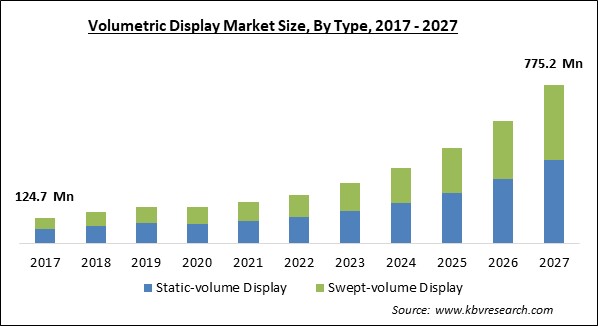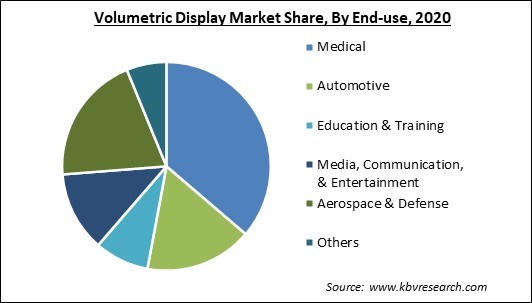The Global Volumetric Display Market size is expected to reach $775.2 million by 2027, rising at a market growth of 25.4% CAGR during the forecast period.
A volumetric display is a graphic display device that creates a three-dimensional visual depiction of an item, as opposed to a flat image on typical screens that simulates depth using a variety of visual effects. 360-degree viewing, agreement of converge and accommodation cues, and their inherent 3D format enable novel user interface techniques are all features of volumetric displays. Technological improvements and innovation in volumetric displays are the result of consistent R&D operations. Many industries, including medical, aerospace and defense, automotive, and industrial, are increasingly commercializing this technology.
The creation and dispersion of visible light from a set of localized and designated locations inside a three-dimensional space are possible with a volumetric display system. A volumetric system can sometimes allow for controlled anisotropic radiation propagation from each of these zones. It can be used to make a three-dimensional image more visible.
The volumetric display with its 3D autostereoscopic display capabilities is used in medical, aerospace and defense, automotive, and industrial applications. Over the last few years, there has been a lot of study into volumetric displays for entertainment and gaming purposes, which has resulted in a lot of technological progress. Human body scans, surgery, and training are all examples of applications in the medical field. In the aerospace and defense industry, volumetric displays are used on the battlefield, for training commanders, and for controlling air traffic, among other things.
In the near future, continued innovation and technological developments to bring higher resolutions and functionalities in 3D display technologies are expected to fuel market growth. Volumetric displays have emerged as a result of ongoing improvements in lasers, optics, and electronics, allowing many viewers to gaze at the image at the same time from different perspectives without the use of special glasses.

The emergence of COVID-19 pandemic had a negative influence on the global display business. Manufacturers suspended their manufacturing operations as a result of the supply interruptions, resulting in sluggish production. In 2020, demand for volumetric displays fell dramatically compared to previous years, owing to a decrease in consumer expenditure and trade restrictions that hampered the availability of raw materials. The market will struggle to recover pre-COVID growth levels in 2021 because of uncertainty about subsequent waves of COVID-19 and anticipated lockdowns throughout key cities.
Governments had imposed limitations on people and commercial traffic as the number of virus-infected persons continues to climb. People were obliged to stay indoors during the initial phase of the pandemic, especially when multiple governments throughout the world enforced partial or complete lockdowns to stop the virus's spread.
Digital technology is used to maximize the picture findings in various medical tests such as X-rays, CRT, and city scans. The volumetric display is commonly utilized in medical imaging applications to visualize various inner body parts using 3D approaches. It provides a one-of-a-kind real-time experience of medical pictures obtained by computerized tomography and magnetic resonance imaging. Thus, the process of diagnosis is likely to improve due to the implementation of volumetric displays. Additionally, because it provides a 3D view of cancer cells and their movements, it is employed in the investigation of external beam cancer treatment for numerous research projects.
The number of smartphone sales keeps increasing year on year in various emerging nations as well as developed nations. Young adults along with adults are spending a significant part of their day online, with their eyes fixated on their smartphone screens. The use of volumetric display in the sector of telecommunications is expected to grow due to its capacity to use the 3-D display as an I/O device for distributed applications. This has the potential to accelerate and lower the cost of product design. Furthermore, if the display's color gamut and resolution improve, it might be used as part of a virtual reality telecommunications system, allowing conference attendees to interact in real-time.
One of the significant restraints is the significant amount of bandwidth needed to send imagery to a volumetric display. For example, a standard 24 bits per pixel, 1024 768 resolution, flat/2D display requires about 135 MB/s to maintain 60 frames per second, whereas a 24 bits per voxel, 1024 768 1024 volumetric display needs about 135 GB/s to maintain 60 volumes per second. As with regular 2D video, the bandwidth required could be reduced by sending fewer volumes per second and allowing the display hardware to repeat frames in the meantime, or by sending only enough data to affect the regions of the display that need to be updated, as in modern lossy-compression video formats like MPEG.

Based on Type, the market is segmented into Static-volume Display and Swept-volume Display. The swept-volume display garnered a substantial revenue share in the volumetric display market in 2020. Swept volume displays re-create volumetric pictures from rapidly projected 2D "slices" using the persistence of human vision. The rise of swept volume displays can be attributable to leading market participants around the world putting a lot of effort into producing sophisticated sweeping volume displays. For example, Voxon Photonics introduced 'Z3D,' the world's first 3D Arcade Machine based on sweeping volume technology, which provides an enhanced gaming experience with an ultra-high digital projection device, in June 2019. Multi-user interaction for gaming and a variety of other applications, such as video calling, is made possible by this technology.
Based on End-use, the market is segmented into Medical, Automotive, Education & Training, Media, Communication, & Entertainment, Aerospace & Defense, and Others. The medical segment garnered the largest revenue share in the volumetric display market in 2020. Volumetric displays have picked up steam in the realm of medical imaging applications due to their major use during surgeries. A volumetric display creates a one-of-a-kind hyper-realistic experience for medical image visualization during surgery. It also creates a 3D representation from recorded MRI data in the systems and allows doctors to zoom in and out of any section of the anatomy.
| Report Attribute | Details |
|---|---|
| Market size value in 2020 | USD 176.6 Million |
| Market size forecast in 2027 | USD 775.2 Million |
| Base Year | 2020 |
| Historical Period | 2017 to 2019 |
| Forecast Period | 2021 to 2027 |
| Revenue Growth Rate | CAGR of 25.4% from 2021 to 2027 |
| Number of Pages | 153 |
| Number of Tables | 277 |
| Report coverage | Market Trends, Revenue Estimation and Forecast, Segmentation Analysis, Regional and Country Breakdown, Companies Strategic Developments, Company Profiling |
| Segments covered | Type, End-use, Region |
| Country scope | US, Canada, Mexico, Germany, UK, France, Russia, Spain, Italy, China, Japan, India, South Korea, Singapore, Malaysia, Brazil, Argentina, UAE, Saudi Arabia, South Africa, Nigeria |
| Growth Drivers |
|
| Restraints |
|
Based on Regions, the market is segmented into North America, Europe, Asia Pacific, and Latin America, Middle East & Africa. The Asia-Pacific segment garnered a substantial revenue share in the volumetric display market in 2020. This is due to shifting consumer preferences in nations like Japan, China, and Australia toward high-tech gaming. Furthermore, due to significant foreign direct investment (FDI) in the region, the quickly rising consumer electronics industry is expected to boost the production and usage of volumetric displays. Moreover, due to mass manufacturing facilities and low production costs, nations such as Japan and China are expected to grab a considerable share in the volumetric display market in the near future.
Free Valuable Insights: Global Volumetric Display Market size to reach USD 775.2 Million by 2027
The market research report covers the analysis of key stake holders of the market. Key companies profiled in the report include Holografika, Looking Glass Factory, Inc., Alioscopy, Lightspace Technologies, The Coretec Group, Inc., Holoxica Limited, and Leia, Inc.
By Type
By End-use
By Geography
Our team of dedicated experts can provide you with attractive expansion opportunities for your business.

